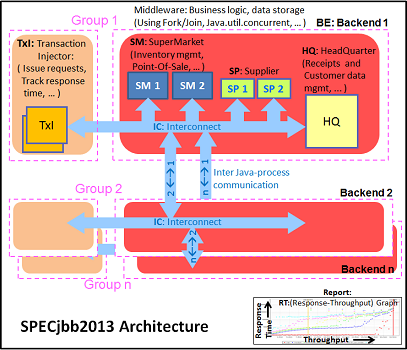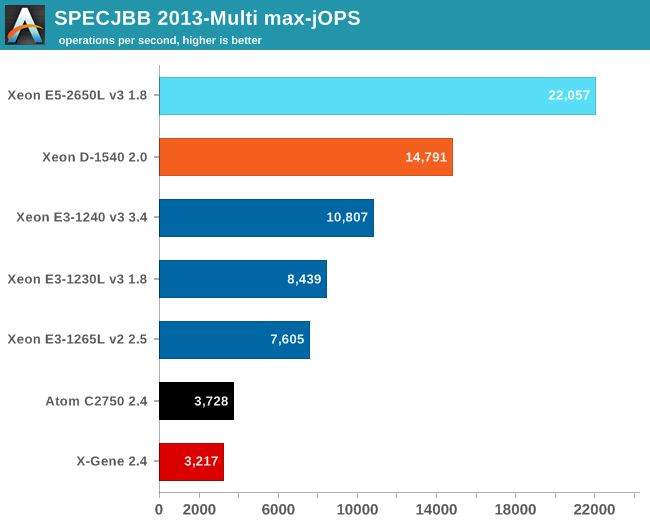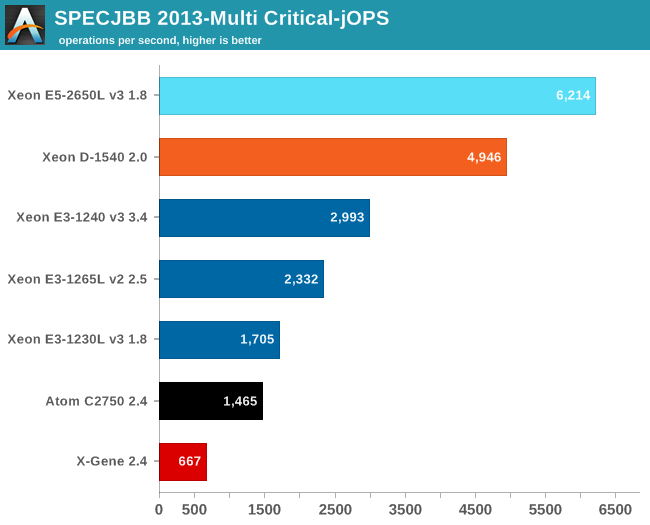The Intel Xeon D Review: Performance Per Watt Server SoC Champion?
by Johan De Gelas on June 23, 2015 8:35 AM EST- Posted in
- CPUs
- Intel
- Xeon-D
- Broadwell-DE
Java Server Performance
The SPECjbb 2013 benchmark has "a usage model based on a world-wide supermarket company with an IT infrastructure that handles a mix of point-of-sale requests, online purchases, and data-mining operations." It uses the latest Java 7 features and makes use of XML, compressed communication, and messaging with security.

We tested with four groups of transaction injectors and back-ends. We applied relatively basic tuning to mimic real-world use. We used this JVM configuration setting for the systems limited to 32 GB (all Xeon E3):
"-server -Xmx4G -Xms4G -Xmn2G -XX:+AlwaysPreTouch -XX:+UseLargePages"
With these settings, the benchmark takes about 20-27GB of RAM. For the servers that could address 64 GB or more (Atom, Xeon D and Xeon E5), we used a slightly beefier setting:
"-server -Xmx8G -Xms8G -Xmn4G -XX:+AlwaysPreTouch -XX:+UseLargePages"
With these settings, the benchmark takes about 43-57GB of RAM. The first metric is basically maximum throughput.

As long as you run enough JVMs on top your server, the Xeon D and Xeon E5 will not dissapoint. The Xeon D is at least 37% faster than the previous Xeon E3 generation, the Xeon E5 delivers 50% more.
The Critical-jOPS metric is a throughput metric under response time constraint.

The Xeon D seems to be slightly hindered by the lack of memory bandwidth in the max throughput benchmark, but less than in our HPC benchmark. It is important to understand that maximum throughput is very important in a HPC benchmark, but for a Java based back-end server, the critical benchmark matters much more than the maximum one. The reason is simple: the critical benchmark tells you what your customers will experience on a daily basis, the maximum throughput benchmark descibes what you will get in the worst case scenario when your server is pushed to its limits.
In the critical benchmark, the Xeon D is at least 65% faster than any Xeon E3. The Broadwell core is a minor improvement over the Haswell core when you look at performance only (single threaded integer performance), but once it is integrated in a chip like the Xeon D, it is astonishing how much performance per watt you get. A 60-70% increase in performance per watt is a rare thing indeed.










90 Comments
View All Comments
AkulaClass - Tuesday, June 23, 2015 - link
Nice stuff. Realy good to see them bringing power consumption down pr. Performance.WorldWithoutMadness - Tuesday, June 23, 2015 - link
Nice way to confuse people. Codename Yosemiteretrospooty - Tuesday, June 23, 2015 - link
Who would this confuse? Apple fans because of the OS witht he same codename?LOL. Believe me they don't know, or care... Most of them aren't even aware of what a "server" chip is, or even what a "server" is used for.
IanHagen - Tuesday, June 23, 2015 - link
Rails developer checking in to remind you that a great chunk of the Rails community develop using OS X to deploy on Linux and hence is aware of "server chips". Even though you said that "most" Apple users don't know what a server chip is and that's accurate, the same could be said about Windows or even Linux common users. Stop patronizing.All being said, I agree with you. Who could possibly confound the Xeon D's codename coincides with OS X's 10.10 name?
WinterCharm - Tuesday, June 23, 2015 - link
First of all, your implication that apple fans don't know jack shit about servers is a broad generalization, and a stupid one at that.Second of all, anyone who knows enough to even consider buying a Xeon and a motherboard that supports it and the ECC memory, probably knows enough to not get confused. And plenty of mac users know what server chips are and what they're used for.
Nice trolling though.
adithyay328 - Tuesday, August 25, 2015 - link
That's not entirely true, but I will agree that people a lot of the people who use Apples( No discrimination intended) only continue to use Apple due to their lack of tech knowledge( like knowing Android is the king :) . And, yes, they probably won;t know what servers even are.jeffsci - Monday, June 29, 2015 - link
Geographic code names are the norm in the computing industry (I think because they cannot be copyrighted) and they end up being reused. For example, Intel Seattle is/was a motherboard and AMD Seattle is/was an ARM64 processor. See https://en.wikipedia.org/wiki/List_of_Intel_codena... https://en.wikipedia.org/wiki/List_of_Microsoft_co... etc. if you would like to look for more examples :-)RaiderJ - Tuesday, June 23, 2015 - link
Any places in the US that the motherboard is available for purchase? Quick checks looks like it's mostly sold out or otherwise unavailable?ats - Tuesday, June 23, 2015 - link
Availability comes and goes. Xeon D has been a big hit in the large scale deployment markets and they've been soaking up a lot of demand for it, both bare and combined on motherboards like the supermicro offerings severely limiting retail availability. But it is available in retail but quantities are limited. Quite a number of people over at servethehome have gotten their hands on them. If you want one, you'll likely have to keep checking the major sites like newegg, amazon, et al for them to come back in stock. Retail boards are generally in the $800-1000 range atm (basically going for full list but then again bare motherboards with 10gbe tend to go for 600+ so its still a good buy and simple new 10gbe cards tend to go for $300-500).ToTTenTranz - Tuesday, June 23, 2015 - link
How come they call this a SoC if there's no integrated module to drive even a simple display, and they apparently need a discrete PCIe graphics card for that D-SUB output?